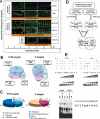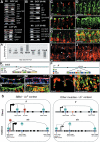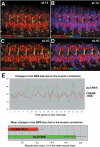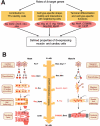Genome-wide view of cell fate specification: ladybird acts at multiple levels during diversification of muscle and heart precursors
- PMID: 18056427
- PMCID: PMC2081981
- DOI: 10.1101/gad.437307
Genome-wide view of cell fate specification: ladybird acts at multiple levels during diversification of muscle and heart precursors
Abstract
Correct diversification of cell types during development ensures the formation of functional organs. The evolutionarily conserved homeobox genes from ladybird/Lbx family were found to act as cell identity genes in a number of embryonic tissues. A prior genetic analysis showed that during Drosophila muscle and heart development ladybird is required for the specification of a subset of muscular and cardiac precursors. To learn how ladybird genes exert their cell identity functions we performed muscle and heart-targeted genome-wide transcriptional profiling and a chromatin immunoprecipitation (ChIP)-on-chip search for direct Ladybird targets. Our data reveal that ladybird not only contributes to the combinatorial code of transcription factors specifying the identity of muscle and cardiac precursors, but also regulates a large number of genes involved in setting cell shape, adhesion, and motility. Among direct ladybird targets, we identified bric-a-brac 2 gene as a new component of identity code and inflated encoding alphaPS2-integrin playing a pivotal role in cell-cell interactions. Unexpectedly, ladybird also contributes to the regulation of terminal differentiation genes encoding structural muscle proteins or contributing to muscle contractility. Thus, the identity gene-governed diversification of cell types is a multistep process involving the transcriptional control of genes determining both morphological and functional properties of cells.
Figures






Similar articles
-
Modifiers of muscle and heart cell fate specification identified by gain-of-function screen in Drosophila.Mech Dev. 2003 Sep;120(9):991-1007. doi: 10.1016/s0925-4773(03)00182-5. Mech Dev. 2003. PMID: 14550529
-
ladybird, a new component of the cardiogenic pathway in Drosophila required for diversification of heart precursors.Development. 1997 Sep;124(18):3471-9. doi: 10.1242/dev.124.18.3471. Development. 1997. PMID: 9342040
-
Shaping leg muscles in Drosophila: role of ladybird, a conserved regulator of appendicular myogenesis.PLoS One. 2006 Dec 27;1(1):e122. doi: 10.1371/journal.pone.0000122. PLoS One. 2006. PMID: 17205126 Free PMC article.
-
A cluster of Drosophila homeobox genes involved in mesoderm differentiation programs.Bioessays. 2001 Feb;23(2):125-33. doi: 10.1002/1521-1878(200102)23:2<125::AID-BIES1019>3.0.CO;2-C. Bioessays. 2001. PMID: 11169585 Review.
-
Acting on identity: Myoblast fusion and the formation of the syncytial muscle fiber.Semin Cell Dev Biol. 2017 Dec;72:45-55. doi: 10.1016/j.semcdb.2017.10.033. Epub 2017 Nov 6. Semin Cell Dev Biol. 2017. PMID: 29101004 Free PMC article. Review.
Cited by
-
Contribution of distinct homeodomain DNA binding specificities to Drosophila embryonic mesodermal cell-specific gene expression programs.PLoS One. 2013 Jul 26;8(7):e69385. doi: 10.1371/journal.pone.0069385. Print 2013. PLoS One. 2013. PMID: 23922708 Free PMC article.
-
Transcription factor lbx1 expression in mouse embryonic stem cell-derived phenotypes.Stem Cells Int. 2011;2011:130970. doi: 10.4061/2011/130970. Epub 2011 Sep 15. Stem Cells Int. 2011. PMID: 21941564 Free PMC article.
-
TRAP-rc, Translating Ribosome Affinity Purification from Rare Cell Populations of Drosophila Embryos.J Vis Exp. 2015 Sep 10;(103):52985. doi: 10.3791/52985. J Vis Exp. 2015. PMID: 26381166 Free PMC article.
-
Dynamics of transcriptional (re)-programming of syncytial nuclei in developing muscles.BMC Biol. 2017 Jun 9;15(1):48. doi: 10.1186/s12915-017-0386-2. BMC Biol. 2017. PMID: 28599653 Free PMC article.
-
Genetic Control of Muscle Diversification and Homeostasis: Insights from Drosophila.Cells. 2020 Jun 25;9(6):1543. doi: 10.3390/cells9061543. Cells. 2020. PMID: 32630420 Free PMC article. Review.
References
-
- Alvares L.E., Schubert F.R., Thorpe C., Mootoosamy R.C., Cheng L., Parkyn G., Lumsden A., Dietrich S., Schubert F.R., Thorpe C., Mootoosamy R.C., Cheng L., Parkyn G., Lumsden A., Dietrich S., Thorpe C., Mootoosamy R.C., Cheng L., Parkyn G., Lumsden A., Dietrich S., Mootoosamy R.C., Cheng L., Parkyn G., Lumsden A., Dietrich S., Cheng L., Parkyn G., Lumsden A., Dietrich S., Parkyn G., Lumsden A., Dietrich S., Lumsden A., Dietrich S., Dietrich S. Intrinsic, Hox-dependent cues determine the fate of skeletal muscle precursors. Dev. Cell. 2003;3:379–390. - PubMed
-
- Baylies M.K., Michelson A.M., Michelson A.M. Invertebrate myogenesis: Looking back to the future of muscle development. Curr. Opin. Genet. Dev. 2001;11:431–439. - PubMed
-
- Briscoe J., Pierani A., Jessell T.M., Ericson J., Pierani A., Jessell T.M., Ericson J., Jessell T.M., Ericson J., Ericson J. A homeodomain protein code specifies progenitor cell identity and neuronal fate in the ventral neural tube. Cell. 2000;101:435–445. - PubMed
-
- Brohmann H., Jagla K., Birchmeier C., Jagla K., Birchmeier C., Birchmeier C. The role of Lbx1 in migration of muscle precursor cells. Development. 2000;127:437–445. - PubMed
Publication types
MeSH terms
LinkOut - more resources
Full Text Sources
Molecular Biology Databases
Research Materials
